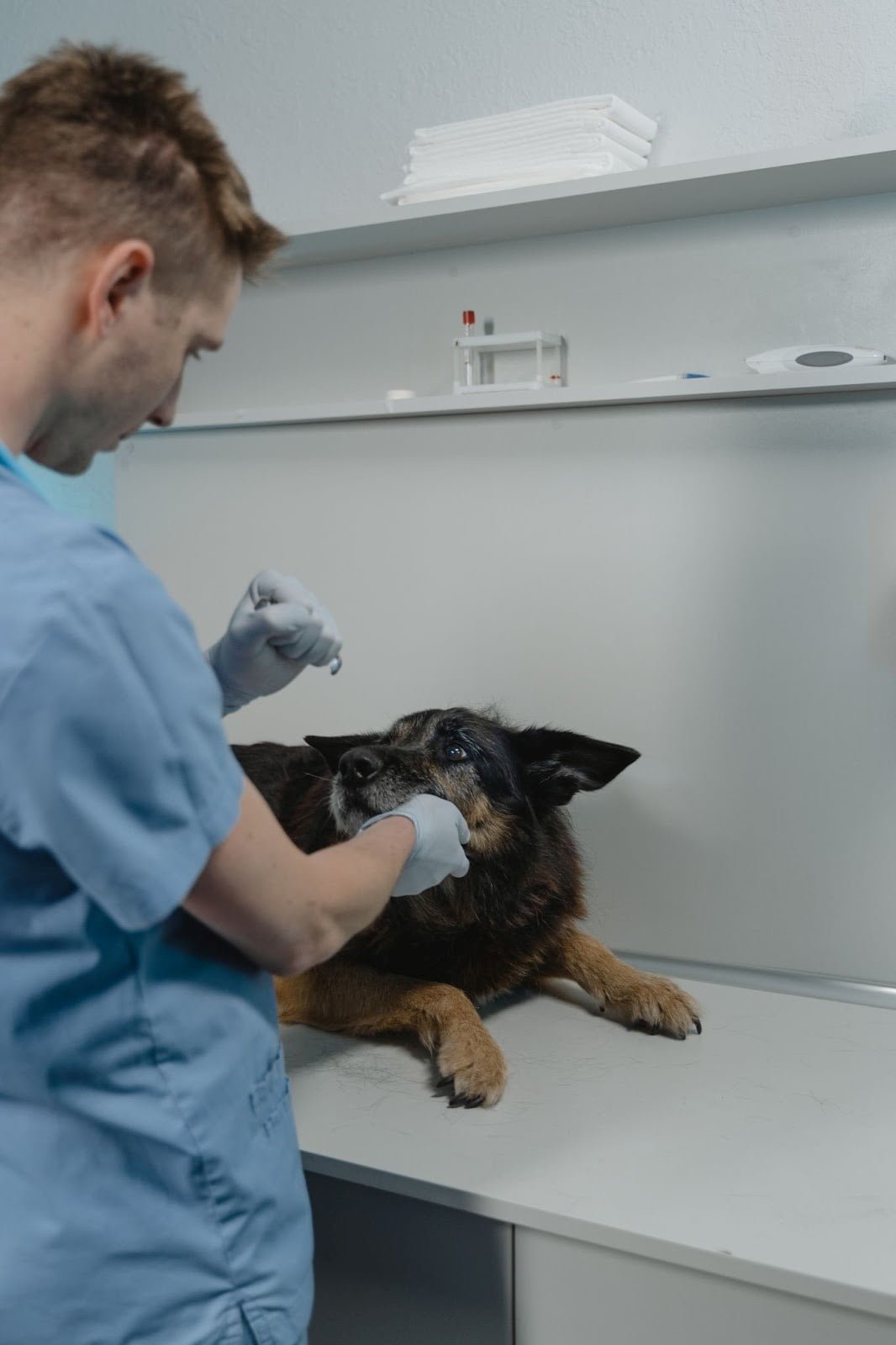As a responsible pet owner, it’s crucial to keep a vigilant eye on your canine companion’s health. One common ailment that dogs can experience is a fever. While they can’t verbally communicate their discomfort, they rely on you to recognize the signs and take prompt action. Check these COMMON SYMPTOMS OF A FEVER IN DOGS!

UNDERSTANDING DOG FEVER
In this comprehensive guide, we’ll explore the common symptoms of a fever in dogs, what may cause it, when to seek veterinary care, and how to provide comfort during your furry friend’s recovery.
What Is a Dog Fever?
A fever in dogs, known as pyrexia, is an elevation of the body temperature above the normal range. While the typical body temperature for dogs varies slightly depending on the breed, it usually falls between 100.5°F to 102.5°F (38°C to 39.2°C). A fever occurs when the body’s internal temperature regulation system is disrupted, often due to an underlying health issue.
Why Do Dogs Get Fevers?
Fever is not an illness itself but rather a symptom of an underlying problem.
Common causes of fever in dogs include:
- Infections: Bacterial, viral, or fungal infections can trigger a fever as the body’s defense mechanism.
- Inflammation: Inflammatory conditions like arthritis or autoimmune disorders can lead to a fever.
- Heatstroke: Exposure to high temperatures and heatstroke can result in a dangerously elevated body temperature.
- Reaction to Medications or Vaccines: Some dogs may develop a fever as a reaction to medications or vaccinations.

IDENTIFYING COMMON SYMPTOMS OF FEVER IN DOGS
The “Telltale” Signs: Recognizing the symptoms of a fever in your dog is crucial for prompt intervention.
Common signs include:
- Elevated Body Temperature | Using a Thermometer: The most accurate way to confirm a fever is by using a rectal thermometer. A body temperature above the normal range indicates a fever.
- Lethargy and Weakness | Reduced Activity: A fever often makes dogs lethargic, causing them to sleep more and show less interest in play or exercise.
- Loss of Appetite | Reduced Food Intake: Dogs with fevers may eat less or refuse food altogether.
- Shivering or Trembling | Chills: Dogs with a fever may shiver or tremble as their bodies attempt to regulate their temperature.
- Increased Thirst | Excessive Drinking: Fever can lead to dehydration, causing dogs to drink more water than usual.
- Rapid Breathing and Heart Rate | Panting: Dogs may breathe more rapidly and have an increased heart rate when they have a fever.
- Warm, Dry Nose and Dry Mouth | Dehydration: Fever can lead to dryness of the nose and mouth, as well as a hot, dry nose.
- Coughing or Sneezing | Respiratory Infections: Fever can accompany respiratory infections, leading to coughing or sneezing.
- Vomiting or Diarrhea | Gastrointestinal Issues: In some cases, fever may be accompanied by digestive symptoms.

When to Seek Veterinary Care
- Taking Action: If you suspect your dog has a fever based on the symptoms mentioned above, it’s essential to take the following steps:
- Check Their Temperature: Gently insert a digital rectal thermometer into your dog’s rectum to measure their temperature.
- Normal Range: A body temperature exceeding 102.5°F (39.2°C) is considered elevated.
- Consult Your Vet: Reach out to your veterinarian and describe your dog’s symptoms, including their body temperature.
- Follow Their Guidance: Your vet will provide guidance on whether to bring your dog in for an examination.
- Avoid Over-the-Counter Medications: Do not give your dog over-the-counter medications without your veterinarian’s approval, as some can be harmful.
- Monitor Your Dog – Keep a Close Eye: Continue monitoring your dog’s temperature and symptoms while following your vet’s recommendations.
Providing Comfort During Dog’s Recovery
Home Care for a Feverish Dog: While your dog is recovering from a fever, you can help by:
- Providing a Quiet and Comfortable Space – Rest: Ensure your dog has a quiet, comfortable place to rest and recover.
- Hydration – Fresh Water: Keep fresh water available at all times to prevent dehydration.
- Feeding – Appetite: Offer easily digestible, bland foods that your dog is likely to eat, or as recommended by your vet.
- Medications – Follow Instructions: If your veterinarian prescribes medication, administer it exactly as instructed.
- Reducing Environmental Stress – Minimize Stress: Keep the environment calm and free from stressors that may exacerbate your dog’s condition.
- Monitoring – Regular Check-Ins: Continue monitoring your dog’s temperature and overall condition.
Veterinary Brief Advice
A fever in dogs can be a worrisome experience for both pets and their owners. By understanding the common symptoms, knowing when to seek veterinary care, and providing comfort during recovery, you can help your furry friend overcome this health challenge. Remember, while a fever itself is not an illness, it is a sign that something may be amiss with your dog’s health.
Prompt attention and care can make a significant difference in their recovery and overall well-being. Always consult your veterinarian for guidance and support when your dog is unwell, and together, you can ensure your beloved companion gets back to their happy, healthy self.

MOST ASKED QUESTIONS ABOUT DOG FEVER
Fever in dogs can be a concerning and confusing issue for pet owners. Knowing how to identify, manage, and understand the implications of a dog’s fever is crucial for their well-being. This article aims to address the most commonly asked questions about fever in dogs, offering insights and guidance to help pet owners navigate this aspect of their pet’s health.
What is Considered a Normal Temperature for Dogs?
A dog’s normal temperature typically ranges between 99.5°F to 102.5°F (37.5°C to 39.2°C). Knowing the baseline temperature is essential for identifying fever.
If your dog’s fever persists for more than 24 to 48 hours, is over 104°F (40°C), or is accompanied by other concerning symptoms, consulting a vet is advisable.
How Can I Tell if My Dog Has a Fever & What Causes Fever in Dogs?
Signs of fever in dogs include lethargy, warm ears and paws, shivering, decreased appetite, and a dry nose. Using a rectal thermometer can confirm fever. Infections, inflammation, immune reactions, heatstroke, and certain diseases or medications can cause fevers in dogs.
Is Fever in Dogs Dangerous & How Can I Treat My Dog’s Fever at Home?
Mild fevers are the body’s natural response to fight infections, but prolonged or excessively high fevers can pose risks and indicate severe underlying issues. Keeping your dog hydrated, providing a comfortable resting area, and using cool compresses on their paw pads can help manage fever at home. However, a vet’s advice is crucial.
Understanding fever in dogs, recognizing its signs, and knowing when to seek professional help are essential aspects of responsible pet ownership. By addressing these frequently asked questions about dog fever, pet owners can navigate this aspect of their dog’s health with confidence, ensuring prompt and appropriate care when necessary.
Recognizing the significance of normal temperature ranges, identifying signs of fever, and knowing when professional veterinary assistance is needed will help pet owners manage their dog’s health and well-being effectively.
Read more on topic at Wiki Pages!



